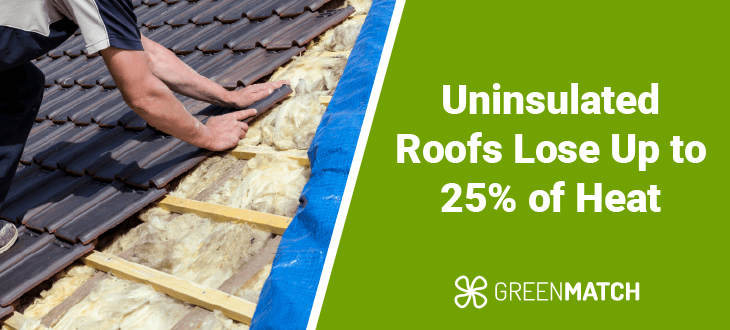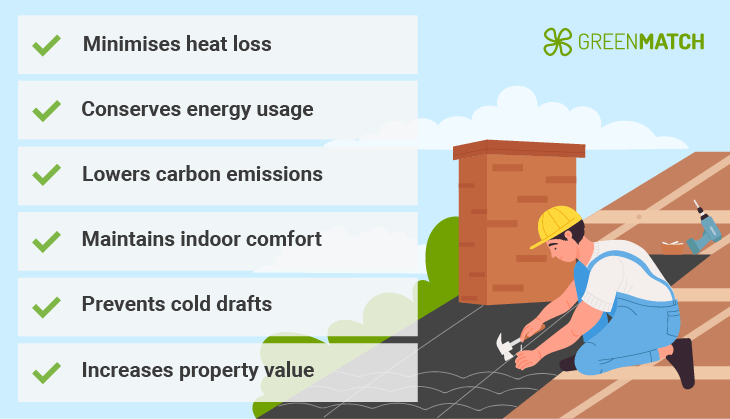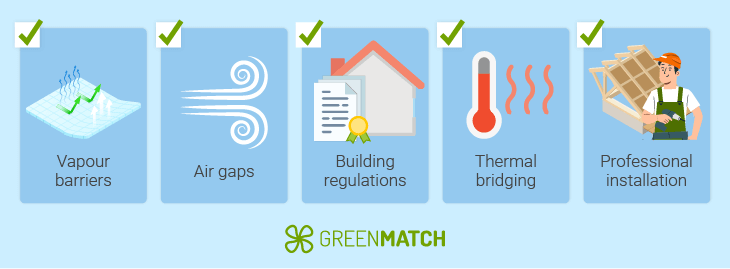Answer these simple questions and we will find you the BEST prices
Which type of solar quotes do you need?
It only takes 30 seconds
100% free with no obligation

Get Free quotes from insulation specialists near you

Save money by comparing quotes and choosing the most competitive offer

The service is 100% free and with no obligation
- GreenMatch
- Insulation
- Roof Insulation
- Insulation Under Roof Tiles
Insulation Under Roof Tiles: What Is It & How to Do It Right


- Without proper insulation, your roof can let up to 25% of your home's heat escape, leading to higher energy bills and discomfort.
- Roof tile insulation can save you up to £225 per year on energy bills, making it a cost-effective investment for UK homeowners.
- Insulation under roof tiles provides year-round comfort with material costs ranging from £5 to £22 per m², depending on the type of insulation you choose
If you're a UK homeowner aiming to improve energy efficiency and comfort, insulating under roof tiles is smart. Roofs are a significant source of heat loss, especially in colder months. Insulation helps keep warmth inside, reduces energy bills, and boosts comfort.
This guide will cover the key benefits of insulating roof tiles, how they work, and why they’re one of the best investments for improving your home’s energy efficiency.
Are you ready to begin your insulation project but need help figuring out where to start? We can simplify the process by connecting you with reliable installers near you. Skip the time-consuming research and comparisons. Fill out the form below in 30 seconds to get up to 3 free quotes from trusted installers near you now!
- Describe your needs
- Get free quotes
- Choose the best offer
It only takes 30 seconds



What is insulation under roof tiles?
Insulation under roof tiles is a method where insulating material is placed beneath the roof tiles. This creates a protective barrier between the interior of your home and the outdoor elements. By insulating this area, heat is kept inside during the winter, and your home stays cooler during the summer, offering year-round comfort.
The process begins by carefully removing the roof tiles to access the underlying structure. Next, insulation materials, such as foam boards or insulating membranes, are installed based on the roof type and desired insulation performance. After securing the insulation, the tiles are reinstalled to protect your home from weather and heat loss. Finally, the roof is inspected to ensure the insulation is effective, the tiles are properly aligned, and no air gaps remain.
Benefits of roof tile insulation

The benefits of roof tile insulation go beyond just saving money on energy bills. Here’s why it’s an essential upgrade for UK homes:
- Reduced heat loss: The roof is one of the main culprits of heat loss in a home. Insulation under roof tiles can significantly reduce the heat escaping through the roof. Up to 25% of heat can be lost through the roof without insulation. Addressing this will keep your home warmer in the winter, reducing your reliance on heating.
- Energy savings: By keeping the heat inside, you'll use less energy to maintain a comfortable indoor temperature, lowering heating bills. In the UK, homes insulated with proper roof insulation can save up to £225 per year on energy bills, making this an excellent long-term investment.
- Reduced carbon footprint: Insulating your roof can also help lower your home's carbon footprint. For example, typical roof insulation can save around 620 kg of CO2 emissions per year, making your home more eco-friendly.
- Enhanced year-round comfort: Insulation under your roof tiles keeps your home warm in winter and cooler in summer, helping maintain a comfortable temperature all year round, no matter the weather.
- Draught protection: Under-roof tile insulation helps block cold draughts by sealing gaps and improving your home's thermal envelope. This makes your home feel more comfortable and reduces the need for heating. Insulating a shed roof and insulating a garage roof would also bring this benefit.
- Increased property value: Homes with effective insulation are more attractive to potential buyers. By upgrading your home with roof tile insulation, you’re investing in long-term savings and potentially increasing its market value. Any insulation upgrades in a home can improve its EPC rating, making the property more appealing to potential buyers and boosting its overall value.
Is roof tile insulation better than other methods?
Compared to other roof insulation methods, insulating under roof tiles—often referred to as warm roof insulation—can be highly effective for thermal efficiency. Positioning insulation directly under the tiles integrates the entire roof structure into the home's thermal envelope, reducing heat loss at the source.
This method offers robust protection against external elements like draughts and moisture, making it a reliable option for consistent comfort and energy savings year-round. However, depending on the specific home design and insulation needs, other methods like loft or roof void insulation might also be effective.
What insulation to use under roof tiles?
Choosing the right insulation under roof tiles is crucial for ensuring your home is well-protected against heat loss and draughts. Various insulation materials are available, each with advantages, disadvantages, and cost considerations. Below are the most commonly used materials for roof tile insulation tailored to UK homeowners.
Rigid foam boards (PIR or PUR boards)
PIR and PUR boards typically cost between £5 and £15 per m², making them a mid-range option for homeowners.
- Excellent thermal performance is due to low U-values (typically 0.022 – 0.028 W/m²K), providing strong heat flow resistance.
- Thin and lightweight, it makes installing under roof tiles easier without taking up much space.
- Moisture-resistant, helping to prevent damp issues.
- Slightly more expensive than other materials.
- It requires precise installation to avoid gaps, which could reduce its effectiveness.
Mineral wool (Glass wool)
Mineral wool generally costs between £13 and £17.50 per m², making it an affordable and widely-used material.
- Widely available and affordable.
- Excellent soundproofing qualities, which can help reduce external noise.
- Fire-resistant, providing extra safety for your home.
- It has lower thermal efficiency than foam boards (U-value ranges from 0.030 – 0.040 W/m²K), which may require thicker layers for the same insulation benefit.
- Absorbs moisture if not properly protected, which could lead to dampness problems.
Sheep’s wool
Sheep’s wool insulation typically costs between £17.50 and £22 per m², which makes it a higher-end option.
- It is natural and sustainable, making it an environmentally friendly choice.
- Effective at regulating humidity and absorbing moisture without losing its insulating properties.
- Naturally fire-resistant and biodegradable.
- It is more expensive than synthetic materials.
- It is less effective for soundproofing compared to mineral wool.
Polystyrene (EPS)
Expanded polystyrene (EPS) costs around £10 per m², making it a budget-friendly option.
- Lightweight and easy to handle, making it more straightforward to install under roof tiles.
- It is reasonably priced compared to other insulation types.
- It provides good moisture resistance and thermal performance.
- Lower thermal efficiency compared to PIR or PUR boards, with U-values ranging from 0.030 – 0.038 W/m²K.
- It is not as environmentally friendly due to its synthetic nature.
Fibreglass
Fibreglass insulation typically costs around £10 per m², making it one of the most economical options.
- It is affordable, widely available, and often used in home insulation projects.
- It is fire-resistant and doesn’t absorb water, making it a safe and reliable option.
- Fibreglass offers good thermal performance with an R-value range of 2.2 to 4.3.
- It can irritate the skin and eyes during installation, so safety precautions are necessary.
- Loses efficiency when compressed or damp.
What is the best insulation material for under roof tiles?
The choice depends on your specific needs, but PIR and PUR boards are excellent for under-roof insulation due to their high thermal performance and space-saving properties. With the lowest U-values, they effectively retain heat in UK homes. Their lightweight, rigid structure allows for seamless fitting under roof tiles, ensuring long-term durability and moisture resistance. Although they may require a higher initial investment, their superior energy-saving potential makes them the best choice for homeowners seeking lasting efficiency and comfort.
Can roof tile insulation be done DIY?
While many homeowners take pleasure in DIY roof insulation projects, tasks like insulating a pitched roof with roof tiles are best handled by professionals. Here’s why:
- Technical skill required: Installing insulation under roof tiles is a complex task. It involves carefully removing tiles, fitting insulation materials correctly, and ensuring the roof is sealed and watertight. Without experience, it’s easy to make mistakes that can lead to heat loss or moisture problems.
- Safety concerns: Working at heights is dangerous. Professionals have the equipment and training to do the job safely, reducing the risk of accidents.
- Maximising energy savings: Incorrectly installed insulation can lead to gaps where heat escapes, meaning you won’t get the energy-saving benefits. Hiring a professional ensures the job is done right the first time so that you can enjoy a warmer, more comfortable home.
If you want to save time and avoid the hassle, let the experts handle it. Hiring a professional lets you enjoy peace of mind, knowing your home will be more energy-efficient and comfortable.
Ready to get started? Fill out the form below in 30 seconds to get up to 3 free quotes from trusted installers near you. Click to get started!
- Describe your needs
- Get free quotes
- Choose the best offer
It only takes 30 seconds



What to keep in mind when adding insulation under roof tiles

When adding insulation under roof tiles, there are several key considerations to keep in mind to avoid installation mistakes and ensure the insulation's effectiveness:
- Vapour barriers: These are essential to prevent moisture from penetrating the insulation, which can cause dampness, mould, and long-term damage to your roof structure.
- Air gaps: Proper ventilation is crucial. Leaving small air gaps ensures airflow, prevents condensation, and maintains a dry roof structure.
- Building regulations: Complying with building regulations for roof insulation is important. These regulations ensure your insulation meets safety and energy efficiency standards. Always check with local authorities or a professional before beginning the project.
- Thermal bridging: Ensure insulation is fitted correctly. If gaps are left, heat can escape through roof rafters. Proper installation minimises this risk and ensures the insulation works effectively.
- Professional installation: Consulting a professional ensures the job is done correctly and according to regulations. They can also advise on the best materials for your roof and climate conditions.
Is it worth insulating under roof tiles?
Yes, insulating under roof tiles is worth it for UK homeowners. Adding insulation under the tiles significantly improves your home's energy efficiency and comfort.
As mentioned earlier, under roof tile insulation reduces energy consumption and helps maintain a consistent indoor temperature, making your home more comfortable all year round. The long-term savings on energy bills often outweigh the initial installation cost, making it a wise investment for any homeowner.
Though DIY may be tempting, professional installation is key to proper roof tile insulation. Experts ensure the tiles are fitted correctly, avoiding heat loss and meeting UK regulations, guaranteeing maximum efficiency and comfort.
Ready to make your home more energy-efficient? Take the next step! Fill out the form below in 30 seconds to receive up to 3 free quotes from trusted professional installers near you. Save on energy bills and enjoy a more comfortable home all year round!
- Describe your needs
- Get free quotes
- Choose the best offer
It only takes 30 seconds



FAQ
Yes, insulating under roof tiles is highly beneficial. It reduces heat loss by 25%, lowers energy bills, and improves indoor comfort throughout the year.
PIR and PUR boards are the best for under roof tile insulation due to their excellent thermal efficiency and moisture resistance. These materials provide strong insulation while being thin and lightweight.
Insulating the underside of your roof is a smart choice for reducing heat loss and improving energy efficiency. Insulation keeps your home warmer by preventing heat from escaping, and professional installation ensures it’s done correctly.
Insulation and a waterproof membrane are important under roof tiles to prevent heat loss and moisture damage. Insulation keeps your home warmer, while a membrane protects against leaks and dampness.

Nicole Bea Kerr is a content writer for Greenmatch, leveraging her experience in B2B journalism and editing. She is interested in bringing more awareness to sustainability through informative narratives.
We strive to connect our customers with the right product and supplier. Would you like to be part of GreenMatch?

- Insulation Under Roof Tiles: What Is It & How to Do It Right
- What is insulation under roof tiles?
- Benefits of roof tile insulation
- What insulation to use under roof tiles?
- Can roof tile insulation be done DIY?
- What to keep in mind when adding insulation under roof tiles
- Is it worth insulating under roof tiles?
- FAQ
- Describe your needs
- Get free quotes
- Choose the best offer
It only takes 30 seconds



